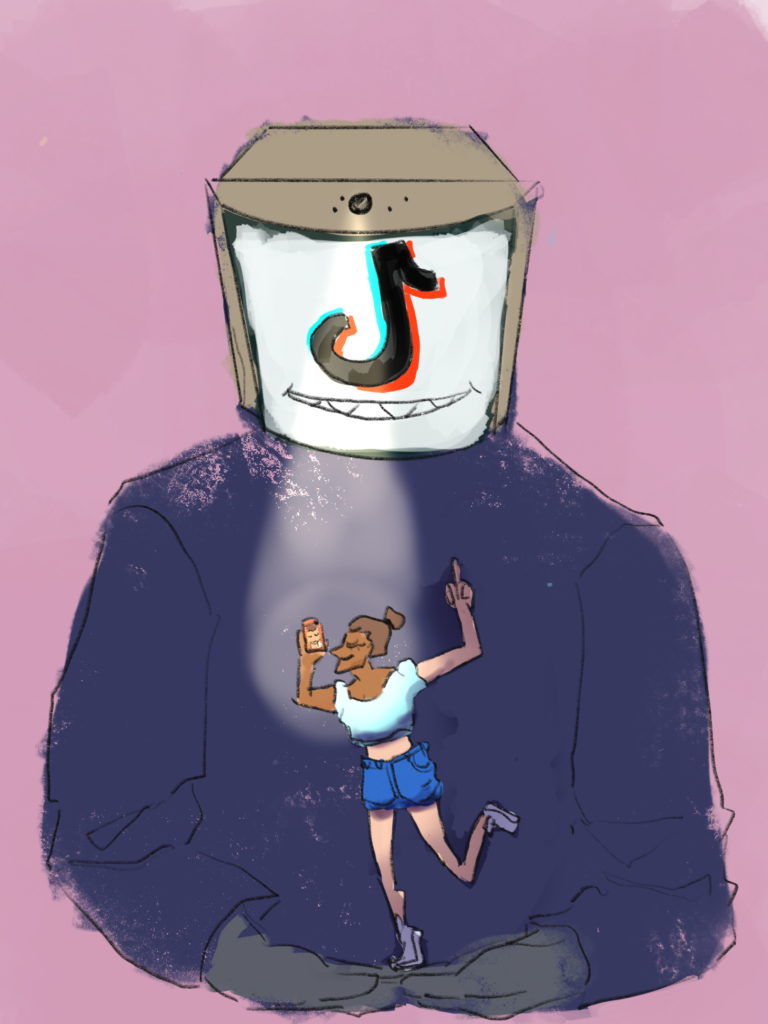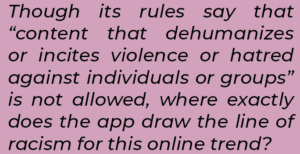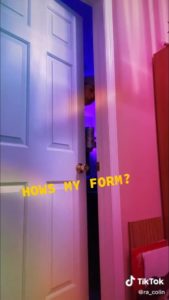
Analissa Nunez
Contributing Writer
When TikTok launched in 2018, the world was unaware of the wide popularity it would have. This social media app allows users to create and share videos such as lip-syncing or dancing to music.
This includes its viral Internet challenges such as the “Renegade,” “Savage,” or “Flip the Switch.” While the app is home to entertaining videos, it’s also a place where there’s a rise in teenagers relying on racist stereotypes to get more followers. The latest trend? The “How’s my form?” challenge.
To do this challenge, a TikToker tries to draw a specific crowd by offering advice to them. Shortly after, the user will display a highly saturated image of themselves imitating a stereotypic action associated with the group and asking, “How’s my form?”
The videos also include the use of excessive emojis or GIFs for the image to resemble deep fried memes. Although some users poke fun at celebrities or parents, the most viewed videos involve mocking people of color.

Last month, two high school students were expelled after participating in the online trend for portraying an inaccurate and racist view of the Black community. Unfortunately, this event isn’t the only one that has reached masses.
Another video came to light after a teenager made a video mocking Black people by mentioning the ⅗ Compromise (an agreement in 1787 debating on whether slaves counted as a person for legislative purposes), and the Jim Crow laws.
Despite the negativity, the trend has seen the rise of online heroes bringing justice to the online community. Once shared online, Twitter users will investigate and share the personal information of TikTok users to face the consequences of their actions.
The use of imitating stereotypical lifestyles of color for comedy or entertainment purposes is no new concept. This strange obsession with Black culture by white people has been ongoing since the 1800s.
Today, this concept is known as “blackfishing,” a term to describe a person pretending to be Black by enhancing their appearance through heavy makeup or hairstyles to perceive that they have Black heritage. From the rapper Bhad Bhabie to social media star Whoah Vicky, the trend of imitating Black culture continues today, mainly seen in social media apps or entertainment.
With new challenges being created every month, the possibility of younger users adhering to racial stereotypes after viewing similar videos is a critical issue. It can be said that today’s teenagers learn more about cultures through social media rather than in the classroom. For that reason, viewing these types of videos could cause younger generations to have an unconscious bias towards people of a certain group all because of an Internet trend.
As per TikTok’s community guidelines, hate speech including slurs and bullying isn’t tolerated on the app. Though its rules say that “content that dehumanizes or incites violence or hatred against individuals or groups” is not allowed, where exactly does the app draw the line of racism for this online trend?
Although users may censor words or use graphics to avoid backlash, we must think of the future and how communities of color may be perceived by others. Essentially, for those that don’t mean to come off as racist, think of the group you’re mocking before you gain that clout.












Hi! I’m Off-Campus Senator Giselle Etessami and I wanted to share some updates about my work. Since the publication of this article, I have passed the Resolution to Direct UCSB to Create Inclusive Academic Policies. I am also in the process of bringing the outdoor gym to Isla Vista (the park has been chosen, equipment and pricing established, and funding will be requested soon). Also, I am in the process of establishing the trash/compost/recycling receptacles that I promised, but there’s a lot of bureaucracy I am trying to navigate.
The bills and resolutions that were listed for each senator will not accurately reflect their commitment to their platforms because projects aren’t accomplished through legislation. Thus, it may be misleading students into thinking that senators haven’t been working on what they said they would if you’re conflating two lists which don’t correspond. I cannot speak to if other senators have been following through on their platforms, but I know I certainly have been devoting a lot of time to doing so.
If you could update this article to include my Resolution to Direct UCSB to Create Inclusive Academic Policies (and feel free to mention the projects as well), it would be more accurate representation of my work and I would be much obliged. Please let me know if you want further clarifications.
Sincerely,
Giselle
Comments are closed.